“You got to go down a lot of wrong roads to find the right one.” – Said Founder of GoDaddy Bob Parsons

“You got to go down a lot of wrong roads to find the right one.” – Said Founder of GoDaddy Bob Parsons

Mad Hedge Technology Letter
February 21, 2019
Fiat Lux
Featured Trade:
(BUY AMD ON THE DIP),
(AMD), (NVDA), (INTC),

I am bullish Advanced Micro Devices (AMD).
The company is doing backflips and edging around other fertile pastures to the dismay of competitors.
They jumped all over Intel’s (INTC) CPU lead promising more cores and adding on more features to lure in a new audience.
In terms of computer graphics, Nvidia (NVDA) still wields more clout in the higher-grade GPU space and AMD has been playing second fiddle with cheaper, value-oriented GPU cards that can be best described as mid-range.
That is about to change.
AMD is at it again acing its attempt to pull down Goliath with its new Radeon VII.
This $700 GPU card is the first 7 nanometer (nm) GPU on the market and is a warning shot to Nvidia who they plan to surgically invade in order to snatch market share.
This new AMD GPU is a direct threat to Nvidia’s set of RTX 2080 graphics cards and is set at the same price point with comparable performance.
The Radeon VII is the next iteration to AMD’s Vega 64 and possesses similar architecture with specific enhancements in clock speeds and VRAM.
Gamers are still on the fence to whether this new product can eclipse the heavily entrenched Nvidia graphics cards that are time-honored, tested and stamped with the industries seal of approval.
It is still uncertain whether AMD can introduce the necessary supply and if you still remember when the prior iteration Vega 64 debuted in 2017, it was a threat to Nvidia’s top-tier GTX 1080, but ran out of inventory quickly.
The new Radeon VII card is one of the best on the market for professional work and still does well in the gaming realm, albeit with a lack of ray tracing.
Few video games support ray tracing currently but new game studios plan to adopt this cutting edge technology later this year.
I commend AMD’s first foray into this part of the niche market and when AMD upgrades its architecture and improves on the next iteration, Nvidia will be squarely in their crosshairs.
The number of new products that drive top-line growth is another reason to be positive on this stock.
Looking at the CPU market – momentum would be the key word to describe AMD’s current trajectory.
For generations, Intel has had a secure stranglehold on this rapidly expanding market, but the fringes of the industry have been hijacked by AMD and they seek to spread its tentacles deeper into foreign CPU waters.
By the end of the year, I believe that AMD will carve out a nice high single digit market share of global CPU sales.
Intel has been bogged down by production setbacks in the deployment of the 10-nm server chip giving AMD a chance to take advantage of this gaping pothole to jack up sales with its EPYC chip.
Not only that, AMD is motoring ahead with a superior 7-nm chip which is a faster processor and is more energy-friendly than Intel’s 10-nm version.
I can conclude that AMD is blowing past Intel in chip technology, and has its third generation of CPUs earmarked for the market in the summer ready to stretch the lead.
CEO of AMD Dr. Lisa Su is compounding the misery for Intel, offering a physical glimpse of plans to roll out its third generation Ryzen CPUs for PCs by the middle of the year at the Consumer Electronics Show in January.
Another catalyst that could drive the stock higher is a favorable earnings outlook in 2019.
After meeting expectations last quarter, expansion is expected in the high single digits in a tough chip environment that has wrought its fair share of carnage.
I wouldn’t pigeonhole the new product line as mere hype, it’s clear they are meaningfully enhanced and improved with each successive iteration.
I estimate that these new products will give AMD solid traction to close in on the competition in the CPU and GPU markets.
Clearly, this isn’t a 1-quarter venture, but visibly aware that AMD is making inroads into other markets are a demonstrably net negative to weight on Intel and Nvidia shares.
This part of tech is not without its headaches and is fraught with China risk.
Chinese gaming regulators have put the kibosh on new gaming licenses and AMD’s scaling back of forecasts should reflect this development.
Intel cited falling spend on server chips and Nvidia came out with a dreadful earnings report to forget lately.
However, when there is blood in the streets, the status quo is ripe for some change and I am confident that AMD can execute this aggressive ramp up after digesting some of the excessive inventory in the first quarter.
As AMD trades at $24, I can’t help but believe this name will end the year higher.
Investors must remember that in the near term, the Fed has hit the pause button aiding the equity market, and China has reportedly been keen on some massive chip purchases to help soothe the nerves of the administration.
If the market can marry this up with favorable reviews of AMD’s latest products, I don’t see why AMD can’t be trading at $30 by the end of the year.
At the Mad Hedge Lake Tahoe Conference, I proclaimed that AMD was one of my favorites going into 2019 and exploded upwards from $17 in October 2018.
AMD truly has not disappointed.

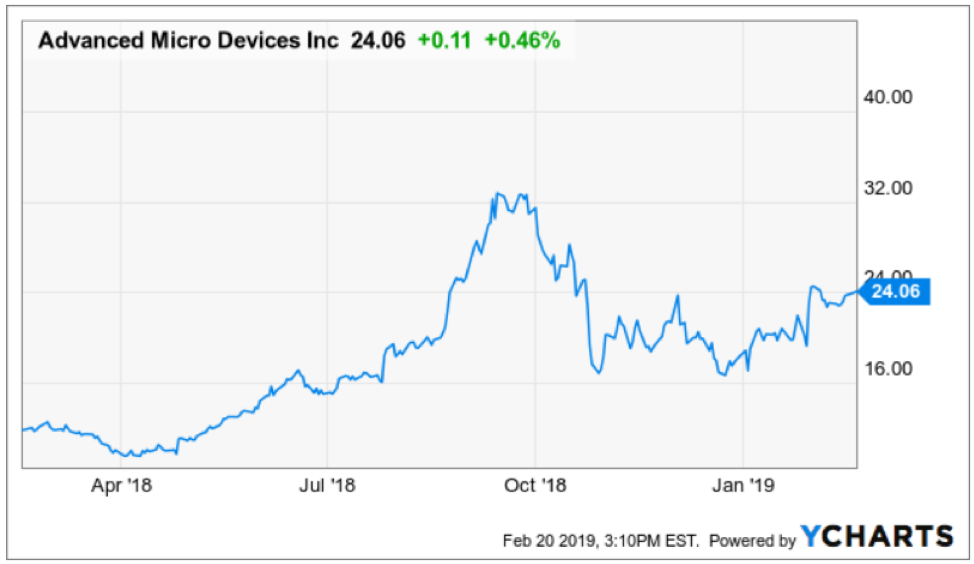
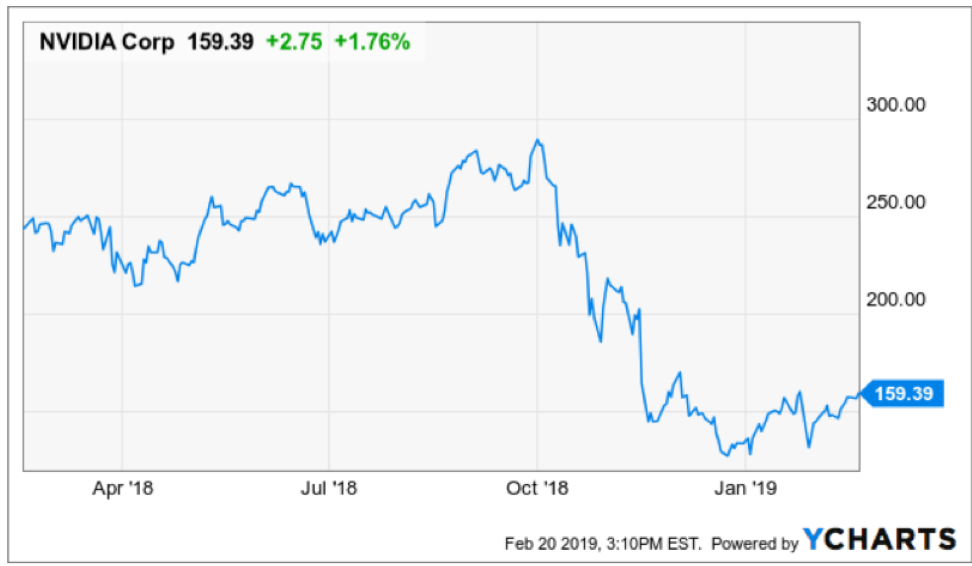
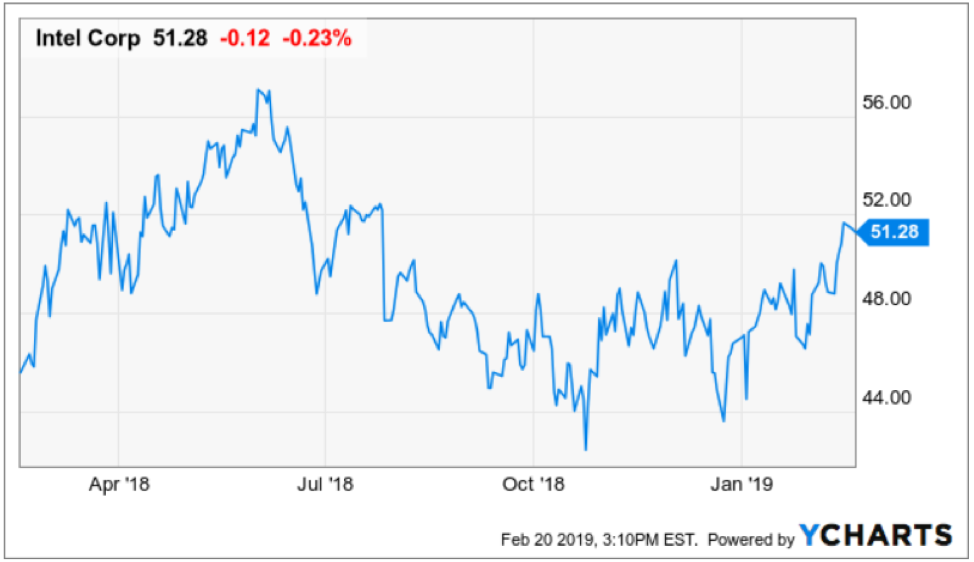
“If you don't have a mobile strategy, you're in deep turd.” – Said CEO of Nvidia Jensen Huang

Mad Hedge Technology Letter
February 20, 2019
Fiat Lux
Featured Trade:
(WALMART’S DRAMATIC SAVE),
(WMT), (AMZN)

This is not your father’s Walmart (WMT).
Peel back a layer or two of that thin veneer and in Walmart, you have nothing closely resembling the Walmart you grew up with.
This would have been a coup de grâce for many companies facing the tsunami of tech strength crushing business models left and right.
Yet, Walmart has found a way to turn the tables and flourish when many industry experts thought this once legacy shopping business was careening towards extinction.
Walmart’s outstanding performance of growing e-commerce sales 43% YOY in the winter quarter of 2018 is a proclamation that they are here to stay through hell or high water and it’s the e-commerce segment leading the charge.
Betting the ranch on e-commerce has them inevitably on a collision course heading directly towards competitor Amazon (AMZN).
Instead of shriveling up and waving the white flag, Walmart’s President and CEO Doug McMillon is acutely aware that the overall pie is growing and there is room for more than just Amazon.
His company’s recent success echoes this trend of the overall marketing growing, and I believe passing the acid test of the 2018 winter shopping season is concrete evidence that Walmart has a prosperous future if they can navigate around four objectives.
First, triple-down on the e-commerce strategy which could translate into being a tad cavalier to operating margins.
This would take a machete to short-term profitability, but I believe Walmart investors are starting to believe in this tech pivot and further margin erosion can be stomached because they are currently conditioned for it.
To capture a larger footprint in the e-commerce market, data analytics specialists will need to be recruited in heavy numbers and convinced of the future vision of Walmart.
The turn of the calendar year means that end of the year bonuses are out and now is the time to capture the horde of tech talent sitting on the open market waiting to be put on Walmart’s books.
Walmart could potentially leap into position to nab some of these tech high flyers who specialize in Python and SQL programming languages. The demand for these wizards is insatiable and the key to any corporate digital migration strategy.
Second, being able to penetrate the target audience a notch above than what Walmart is traditionally accustomed to.
This would correlate into higher average spend per Walmart transaction which would become a feedback loop into Walmart carving out higher-grade product line-ups to compensate increasingly pressured margins.
Third, enhance the logistics and fulfillment strategy by automating more of the business process through robotics and a streamlined IT department.
Walmart has been in the process of scaling out this portion of the business process and they are probably the only one that can pull this off because of the gigantic addressable market and flowing access to capital.
Fourth, originate an educational program coaching up spendthrift customers on how to access its products digitally.
Investors must remember that a large swath of Walmart’s customers aren’t at the top of the socioeconomic ladder and seamlessly culling them into the digital orbit is a responsibility shouldered on upper management.
The goal is to gradually migrate every type of order variant online or through self-checkout means, and self-navigating through these payment and service barriers could be a hindrance as Walmart’s customer base is less tech-savvy than Amazon’s prime subscription customer base.
However, the smaller digital native customer base on a percentage basis is offset by the 4,700 physical stores allowing these partially digital-savvy customers to click and collect.
I view the click and collect distribution channel as a bridge towards becoming fully digital and if Walmart can provide superior customers service, this cohort will likely stick with Walmart’s full-service digital offerings in the future once they upgrade.
In the distant future, it’s almost guaranteed these physical stores end up as fulfillment centers with robotic automation or some type of mix of the two.
Walmart is starting to get serious looks as an e-commerce powerhouse, and I have consistently described Walmart as the next FANG. This latest earnings report reinforces this thesis.
I champion some of the moves to add to product lines such as online brands Art.com and female garment retailer Bare Necessities.
If Walmart could whip up an in-house brand similar to Amazon Basics, that would also be a gamechanger. That step is down the road and Walmart would need to accumulate higher expertise to convert certain products from the 3rd party variety.
Another growth inducer would be establishing a subscription-based service similar to Amazon Prime. Software as a subscription (SaaS) is all the rage in technology and for all the right reasons as this recurring revenue is a boon for the CFO and stabilizes finances.
The Arkansas-based firm forecasted e-commerce annual sales growth of 35% and indicated that huge sums of capital would be allocated into remodeling store units, reinforcing the e-commerce platform, and juicing up its supply chain operations.
Walmart is only scratching the surface and it would take a debacle of epic proportions or a massive recession crimping product demand to knock off Walmart from this high-speed train of positive momentum.
Yes, I agree this company isn’t even close to Amazon now, but the catch-up potential and that path to catch up is clear as daylight.
There is no need to chase shares at this price, but I can say that Walmart is on the verge of locking itself up at the $100 price point as an eternal support level moving forward.
If shares sell off to $90 because of the recent buying from oversold conditions, it could be one of the last times ever to secure a price that cheaply for a precious FANG company.
The company is also famous for continuously raising its dividend.
Walmart is an intriguing stock for the rest of 2019, particularly if the momentum snowballs from here.
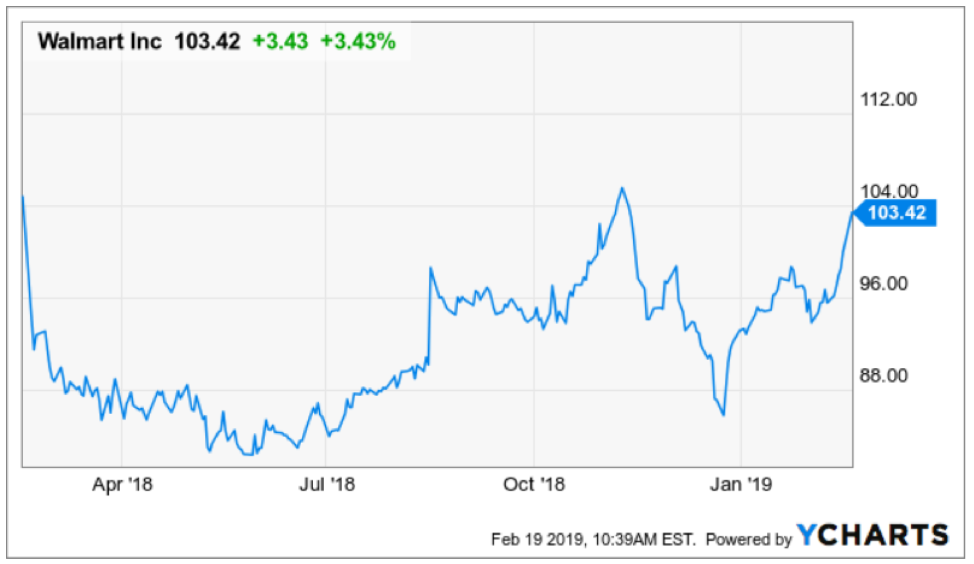
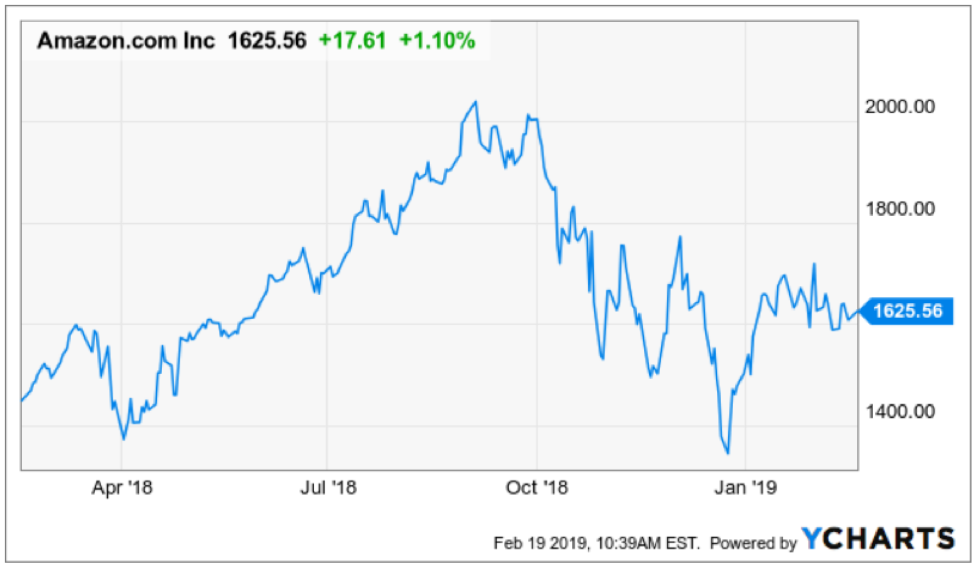
“There are seven billion people in the world. And I think phones are the first time most people will have access to a modern computing device. With Android, we want to enable that for people.” – Said CEO of Google Sundar Pichai

Mad Hedge Technology Letter
January 31, 2019
Fiat Lux
Featured Trade:
(APPLE SEIZES VICTORY FROM THE JAWS OF DEFEAT),
(AAPL)

After an almost 40% swan dive, Apple has found solid footing at these levels for the time being. 40% seems to be the magic number. Declines ALWAYS end at 40% with Apple.
About time!
It’s been an erratic last few months for the company that Steve Jobs built and this last earnings report will go a long way to somewhat stabilize the short-term share price.
The miniscule earnings beat telegraphs to investors that the bad news has been sucked out.
That is what Tim Cook wants the investor community to think.
But is he right?
I would argue that the bad news is over for the short-term but could rear its ugly head again later – it all rides on China’s shoulders.
Let’s take a look at the numbers.
Chinese revenue was down 27% YOY locking in $13.17 billion in quarterly revenue compared to $17.96 billion the prior year.
There is no two ways about this – it’s an awful number and a hurtful manifestation of the Chinese economy decelerating.
The unrelenting pressure of the geopolitical trade war has handcuffed Beijing’s drive to deleverage its balance sheet and steer its economy to a more consumption-supportive model.
China is lamentably back to its traditional ways - the old economy - infusing $2.2 trillion into its balance sheet along with cutting the reserve ratio for state banks hoping to incite economic growth.
Positive short-term catalyst but negative long-term consequences.
This is why I urged Apple lovers to stay away from this stock earlier because of the uncertainty of its current strategic position.
It makes no sense to place an indirect on the current Washington administration navigating a China soft landing.
As it stands, most of Apple’s supply chain is in China and moving it out will be done in piecemeal which is happening behind the scenes and will cause massive job loss in China further hurting the Chinese economy.
The ratcheting up of tensions signals the untenable end of American tech supply chains in China and no new foreign investment will pour into China.
Maybe even never.
I wholeheartedly blame CEO of Apple Tim Cook for not foreseeing this development.
That is what he is paid to do.
Then there is the issue of iPhone sales in China.
Chinese citizens aren’t buying iPhones because of three reasons.
The cohort of wealthy Chinese who can afford a $1,000 iPhone might think twice if they want to be seen outside with a product from a country that is becoming adversarial. Apple has incurred hard-to-quantify brand damage to its once pristine brand in a land that once worshipped the company.
The refresh cycle has elongated because Apple manufactures great smartphones and iPhone holders are waiting it out on the sidelines two or even three iterations down the road to upgrade because that is when they can unearth the relative value of the product.
Lastly, local Chinese smartphone markers have greatly enhanced their products because of a function of time and borrowed Western technology. It is now possible to buy a smartphone that offers around 80% of performance and functionality of an iPhone but for less than half the price.
The customers on the fence who once viewed iPhones as a must-buy are now migrating to the local Chinese competitor because they are a relatively good deal.
I can surmise that these three headwinds are just beginning and will become more entrenched over time.
If the trade war becomes worse, the brand damage will accelerate. iPhones are becoming incrementally better which will delay new iPhone upgrades unless something revolutionary comes out that requires customers to upgrade to be a part of the new technology.
And sadly, Chinese competition is catching up quicker than Apple can innovate and that will not stop.
However, the silver lining is that the worst-case scenario won’t happen in the next quarter and the market won’t get wind of this until the second half of the year.
Instead of a meaningful sell-off because of this earnings report, Cook chose to front-run the weakness by reporting the hideous performance at the beginning of January.
Cook knew he needed to come clean with the negative news and the reformulated projections that were re-laid a few weeks ago were the same ones that Apple barely beat by one cent on the bottom line by posting EPS of $4.18 and marginally on the top line by $420 million.
I am in no way saying that this was a great earnings report – it wasn’t.
Apple mainly delivered on the mediocrity that they discussed a few weeks ago lowering the bar to the point where it would be a failure of epic proportions if Apple couldn’t beat significantly revised down earnings.
Then the outlook for the next quarter wasn’t as bad as people thought, but that doesn’t mean it was good.
When you start playing the game of not as bad as the market thought – it is a slippery slope to head down and halfway to the CEO getting sacked down the road.
I mentioned before that the macro headwinds came 2 years too early for Cook and pegging 60% of company revenue to a smartphone which has trended towards mass commoditization is a bad bet.
Cook has been painstakingly slow rewriting Apple as a service company which is his current get-out-of-jail-free card dangling in front of him like a juicy carrot.
iPhone gross margin is now 34.3% which is lower than the other Apple products whose margins are 38%.
Their flagship product isn’t as profitable on a per-unit basis as it once was highlighting the necessity for refreshing the product lines with not just new iterations but game-changing products.
The type of products that Steve Jobs used to mushroom popularity would suffice.
Gross margins will continue to come down as the smartphone market is saturated and customers won’t buy iPhones now unless they receive a drastic price reduction.
The result is that Apple no longer publishes iPhone unit sales to conceal the worst number for their most important and volume-heavy product.
A little too late if you tell me and irresponsible to investor transparency if you ask me.
Apple Pay, Apple Music, and iCloud storage eclipsed $10.9 billion demonstrating a 19% YOY increase.
This shows that this company still has strengths, but don’t forget that services are still less than 15% of total revenue even though they are the fastest growth part of their portfolio.
Cook isn’t doing enough to supercharge the content and services at Apple.
The top line number was $84.3 billion, a 5% YOY decline in revenue – a YOY decline hasn’t happened in 18 years and this is deeply troublesome.
Let me explain why Cook is the center of the problem.
The underlying issue is Cook doesn’t know what product should be next for Apple.
Apple dabbled with the Apple TV which didn’t pan out.
Then the autonomous vehicle unit just closed down sacking 200 employees.
And the content side of it hasn’t been developed fast enough relative to the slowing down of iPhone sales which is why you can blame Cook for being reactive instead of proactive.
It’s not like he can claim that his head was in the sand and couldn’t take note of what Netflix was doing and had gotten into that original content game sooner.
The hesitation is exactly what worries me with Cook. Cook is a great operations guy and can take an existing product, beef up margins, shave down expenses, streamline execution and boost top and bottom line profits.
Cook is being painfully exposed now that he is out of his comfort zone and must aggressively move in a direction that doesn’t have a red carpet laid out for him.
Even though the pre-earnings red flag raised many questions, Cook only satisfied these red flags on a short-term basis and Apple still needs to reconfigure its product roadmap for the long term.
If Cook plans to milk more out of the iPhone story, Apple becomes a sell the rallies stock, but the market will give the benefit of the doubt to Apple for a quarter or so.
The 800-pound gorilla in the room is the Chinese economy which could go into a hard landing if the stimulus fails to deliver economic respite or if the trade war tensions are exacerbated.
At the bare minimum, the waterfall of downgrades should be over for the time being, but this will come to the fore in a quarter or so when Apple will need to shine light on its plans moving forward.
I wouldn’t bet the ranch on Cook being innovative.
It looks like Apple will start to trade in a range.
It’s hard to believe any bad news superseding what came out at the beginning of this month in the short-term, but at the same time, there are no idiosyncratic catalysts to cause this stock to bullishly break out.
We are at an inflection point in Cook’s career and he is finding out that it's not as easy to be Apple as it used to, and mammoth decisions are on the horizon that must be addressed or possibly become the next IBM.
If you ask me, I’ve been calling on Apple to replace Cook for a while with Jack Dorsey as the signal caller, I still believe this is the only way to stay in the heavyweight division of tech titans five years from now.
Such is the competitive nature of the tech landscape these days.
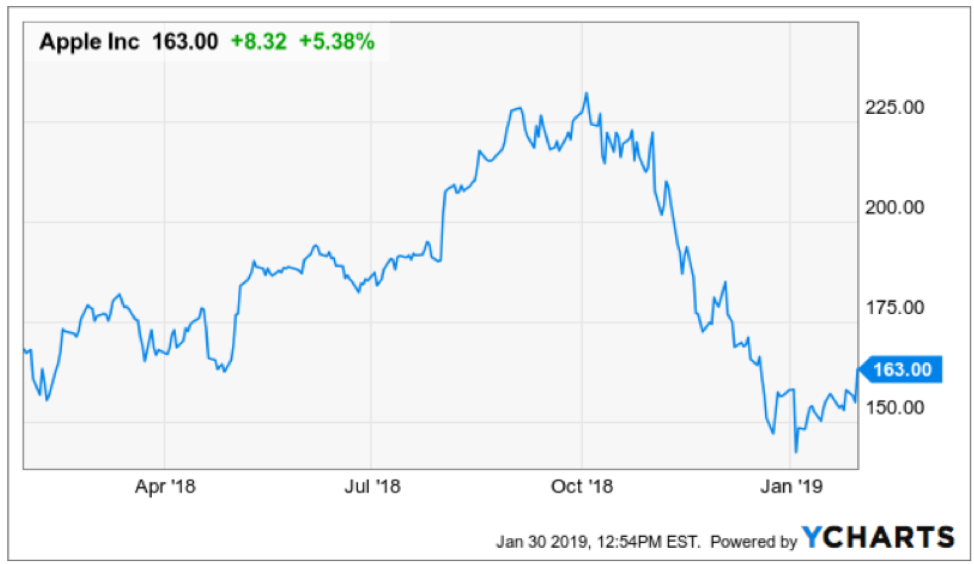
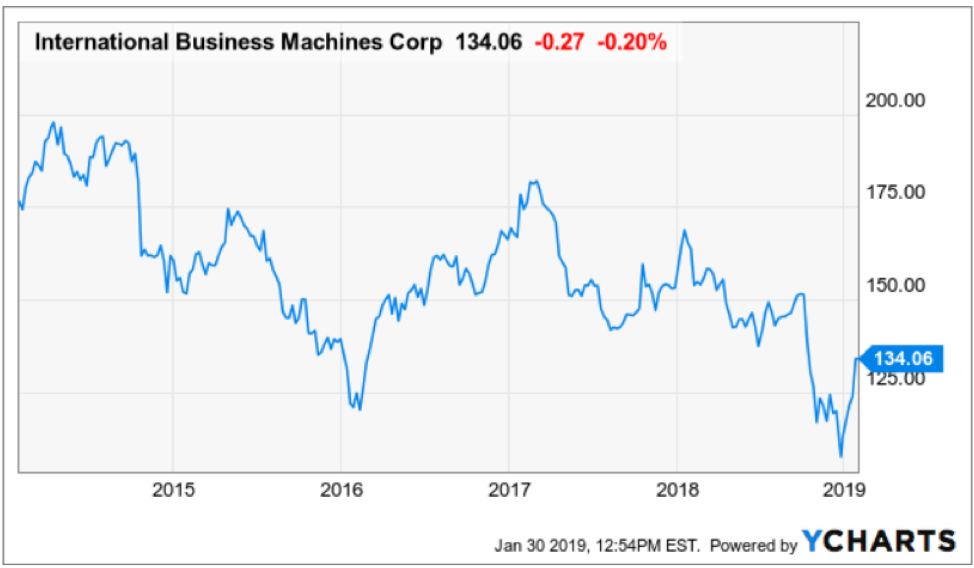

Mad Hedge Technology Letter
January 30, 2019
Fiat Lux
Featured Trade:
(IS THE BOTTOM IN FOR FACEBOOK?),
(FB)

Legal Disclaimer
There is a very high degree of risk involved in trading. Past results are not indicative of future returns. MadHedgeFundTrader.com and all individuals affiliated with this site assume no responsibilities for your trading and investment results. The indicators, strategies, columns, articles and all other features are for educational purposes only and should not be construed as investment advice. Information for futures trading observations are obtained from sources believed to be reliable, but we do not warrant its completeness or accuracy, or warrant any results from the use of the information. Your use of the trading observations is entirely at your own risk and it is your sole responsibility to evaluate the accuracy, completeness and usefulness of the information. You must assess the risk of any trade with your broker and make your own independent decisions regarding any securities mentioned herein. Affiliates of MadHedgeFundTrader.com may have a position or effect transactions in the securities described herein (or options thereon) and/or otherwise employ trading strategies that may be consistent or inconsistent with the provided strategies.
This site uses cookies. By continuing to browse the site, you are agreeing to our use of cookies.
OKLearn moreWe may request cookies to be set on your device. We use cookies to let us know when you visit our websites, how you interact with us, to enrich your user experience, and to customize your relationship with our website.
Click on the different category headings to find out more. You can also change some of your preferences. Note that blocking some types of cookies may impact your experience on our websites and the services we are able to offer.
These cookies are strictly necessary to provide you with services available through our website and to use some of its features.
Because these cookies are strictly necessary to deliver the website, refuseing them will have impact how our site functions. You always can block or delete cookies by changing your browser settings and force blocking all cookies on this website. But this will always prompt you to accept/refuse cookies when revisiting our site.
We fully respect if you want to refuse cookies but to avoid asking you again and again kindly allow us to store a cookie for that. You are free to opt out any time or opt in for other cookies to get a better experience. If you refuse cookies we will remove all set cookies in our domain.
We provide you with a list of stored cookies on your computer in our domain so you can check what we stored. Due to security reasons we are not able to show or modify cookies from other domains. You can check these in your browser security settings.
These cookies collect information that is used either in aggregate form to help us understand how our website is being used or how effective our marketing campaigns are, or to help us customize our website and application for you in order to enhance your experience.
If you do not want that we track your visist to our site you can disable tracking in your browser here:
We also use different external services like Google Webfonts, Google Maps, and external Video providers. Since these providers may collect personal data like your IP address we allow you to block them here. Please be aware that this might heavily reduce the functionality and appearance of our site. Changes will take effect once you reload the page.
Google Webfont Settings:
Google Map Settings:
Vimeo and Youtube video embeds:
